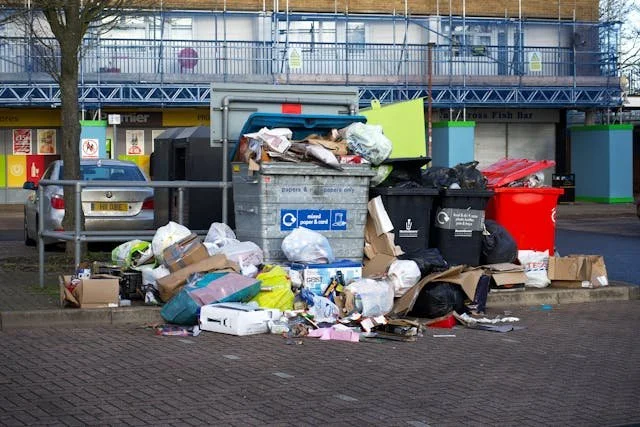Why 2025 is a breakthrough year for Zero-Waste
The 2025 Reckoning
Back when 2030 seemed like the distant future, it was set as a target year. “We’ll hit our milestones in 2030.”
But as 2025 approached, companies confronted a harsh reality: they were not on track to meet their goals. In the consumer goods sector, several high-profile brands pushed back their 2025 waste and packaging commitments, retreating from earlier promises.
Across the industrial sector, over 70% of companies with zero-waste programs struggled to meet their targets. Huge investments and earnest intentions have not overcome persistent challenges like inadequate infrastructure, high costs, and complex supply chains. Utilities like water and energy are usually metered, and can be monitored somewhat regularly. Waste is different, and it needs different tools to help teams understand where to focus.
In commercial real estate (CRE), the challenge is magnified by decentralized operations. Property owners are often held accountable for aggregate waste outcomes across their portfolios, even though day-to-day waste generation is heavily driven by tenants whose activities and data are fragmented. Landlords lack direct control over tenants’ waste practices, and getting consistent waste metrics from multiple occupants is difficult. In fact, while 80% of real estate investment trusts (REITs) report on waste volumes and diversion rates, only 22% have set public waste reduction goals. This gap suggests that CRE owners hesitate to commit to hard targets without confidence in the underlying data and levers – a hesitation now coming to a head in 2025.
The Data Problem Behind Missed Goals
A core issue is that waste remains largely invisible and unmeasured compared to other utilities. Unlike electricity or water, which flow through meters, there is no universal “waste meter” to provide real-time, standardized data on waste generation. Instead, waste data is scattered across a patchwork of sources: hauler weight tickets and invoices, disposal facility reports, recycling vendor spreadsheets, ad-hoc tenant logs, even periodic waste audits and surveys. Each source uses its own formats (tons vs. cubic yards, wet weight vs. dry weight), covers different time periods, and may categorize waste streams differently. The result is fragmented data that is laborious to compile and compare.
As one waste management firm noted, “even if you’re able to get ahold of all of your waste invoices, analyzing them is difficult because data is often inconsistent and hard to verify”. There is no standardization – one recycler’s “organics” might be another’s “food waste”; contamination rates might be reported or ignored; some haulers provide weight tickets, while others bill by container size. According to the UN’s global waste outlook, this lack of common definitions and monitoring systems is a worldwide problem: many jurisdictions have no official, reliable waste data at all, and methodologies vary widely, making comparisons challenging. When it comes to waste, you can’t manage (or meet targets for) what you can’t measure.
The data fragmentation doesn’t just frustrate reporting – it actively impedes progress. Without a trusted, unified waste baseline, facility managers and sustainability teams lack visibility into where they stand or where to focus. Are we diverting 50% of waste from landfill, or 75%? Which sites or tenants are lagging? The data trickles in late, in incompatible formats, requiring hours of manual clean-up and consolidation. Surveys show sustainability professionals spend an estimated **70% of their time on data collection and validation tasks, often using manual spreadsheets**. This heavy lift delays decision-making and saps resources that could be spent on actually implementing climate projects.
The good news is that these data headaches are fixable. With the right approach, companies can turn this around and use data to drive improvement (we’ll detail a practical model shortly). First, though, it’s important to recognize why 2025 is a pivotal moment for waste initiatives: external pressures are rising that make ignoring the data problem no longer tenable.
Why 2025 Is Different
The landscape around waste management in 2025 is markedly different than it has been in years past. For one, regulatory and disclosure pressures have intensified. Governments are moving from voluntary guidelines to mandatory requirements, especially through extended producer responsibility (EPR) laws that put the onus on producers to fund and improve waste recovery. In the U.S., eight states have introduced packaging EPR legislation set to take effect around 2025. Likewise, emerging disclosure standards - from the SEC’s climate risk rule to global ESG frameworks (GRI, SASB, and the new ISSB standards) - are expanding the scope of required waste and circularity reporting. What was once a nice-to-have metric is quickly becoming a must-report item, with auditors and investors expecting reliable data.
At the same time, investor and tenant expectations are escalating, and tenants are raising the bar – many corporate tenants have their own zero-waste or ESG goals and require transparency from their landlords on waste metrics to help meet those goals. In practice, this is showing up through green lease clauses and RFPs. Over 60% of new commercial leases now include requirements for eco-friendly practices (recycling programs, data sharing on utilities, etc.), reflecting tenant demand for buildings that align with their values. In short, if you can’t provide robust waste data and services, you risk losing or displeasing major tenants. The message is clear: transparency on waste is no longer optional.
Finally, economic pressure is adding urgency. Waste hauling and disposal costs have been climbing steadily, turning inefficient waste management into a direct hit on the bottom line. Nationwide, waste removal fees are rising faster than general inflation due to higher fuel prices, labor shortages, and new environmental compliance costs that have driven up the price that haulers charge businesses. At the same time, landfills are reaching capacity, and landfill tipping fees (the cost per ton to dump trash) have increased in many regions. Companies that aren’t closely managing their waste streams can end up overpaying for hauling services they don’t need, or get hit with contamination surcharges that they never even notice on their invoices. With disposal costs projected to keep rising, the financial case for waste efficiency has grown. Every dumpster of avoidable trash or unrecycled material is money being thrown away.
The organizations that respond proactively will not only avoid penalties and reputational hits – they’ll likely save money and strengthen their stakeholder relationships in the process.
How CRE & Corporates Can Respond: WATS’ Four-Step Framework
Facing the 2025 reckoning, companies need a practical game plan to get their waste initiatives back on track. Whether you’re a CRE portfolio owner or a manufacturer, the solution starts with treating waste data as a strategic asset rather than an afterthought. WATS (Waste Administration + Tracking Software) uses a four-step framework to turn waste from a messy compliance headache into a source of actionable insight and value. The four steps WATS follows are: Collect, Standardize, Visualize, Optimize, Centralize:
Collect – WATS begins by capturing all relevant waste data. This means ingesting information from every waste stream and service provider: invoices from haulers, pickup frequencies, volumes, as well as any on-site measurements (like smart sensor readings) if available. For property managers, it also includes getting periodic waste data from tenants (or better, encouraging tenants to log into the software and engage with their waste data through a centralized platform). The goal is to build a complete understanding of what waste is being generated, where, and how it’s being disposed. In the collection step, coverage is key: the goal is to gather all the disparate data points into one place so you can see the full picture.
Digitize – Once the raw data is collected, WATS normalizes it into a common format and language. This step is crucial: it transforms fragmented inputs into apples-to-apples metrics. Standardization involves converting units, harmonizing waste categories, and applying consistent time frames. By standardizing units and definitions, you create a single source of truth that stakeholders can trust. Without this step, you’ll continue drowning in conflicting numbers. Common data taxonomy is the foundation for meaningful analysis.
Visualize – With standardized data in hand, the next step is to make it visible through intuitive dashboards, reports, and alerts. People are often surprised once waste metrics are laid out in charts and graphs – trends and anomalies leap off the page. For example, you might visualize each building’s landfill tonnage and quickly spot that one office property is sending twice as much to landfill as the others. Or you might see seasonal spikes in waste that correlate with specific events or tenants. The idea is to turn the data into insights that non-analysts can grasp at a glance. Dashboards that show diversion rates, hauling costs, and service levels across a portfolio can drive healthy competition and accountability (e.g. a property manager asking “why is my site’s recycling rate lower than my peer’s?”). This step brings waste data out of the filing cabinet and into management discussions on a regular basis.
Optimize – Data is only valuable if you act on it. The fourth step is to use the insights from your waste data to drive operational improvements. Armed with data, organizations can identify opportunities to right-size and refine their waste management. Companies have used waste analytics to renegotiate vendor contracts; e.g. eliminating redundant pickups, or adding recycling service where it was missing. Waste composition data can highlight what materials are making up most of your waste stream, suggesting targeted reduction initiatives (like a campaign to switch from disposable palettes to reusables, if wood waste is high). Optimizing might also mean piloting new technologies: the data could reveal that an investment in an on-site compactor or baler would pay off by reducing hauling trips. In short, this step is about turning data insights into action: reducing waste generation, improving diversion, and cutting unnecessary waste handling costs. Companies can see quick wins here. For example, Regency Centers (a retail REIT) reported raising one shopping center’s diversion rate from 0% to 62% and saving money after implementing targeted changes like expanded composting and adjusted pickup frequencies.
By following these four steps – Collect, Digitize, Visualize, and Optimize, organizations create a unified, data-driven system that continuously improves waste outcomes. What once required scrambling to gather data for annual reports becomes a centralized platform where accurate, real-time insights drive daily decisions. Waste data evolves from an afterthought to an integrated management tool and strategic KPI - visible across teams, comparable to energy, water, and carbon metrics.
Looking Ahead
It’s obvious that 2030 will not be a finish line for zero-waste ambitions. Instead, 2025 is a turning point. The experiences of the past few years – missed targets, public accountability, and rising external pressures – have been a wake-up call. As one industry analyst observed, the sustainability narrative is shifting “from lofty ideals to confronting limitations and recalibrating strategies to reflect the reality of the marketplace”. Organizations will need to set more realistic interim goals, invest in the infrastructure and data systems to support them, and align their waste strategies with the evolving regulatory environment - with a much heavier emphasis on measurement, transparency, and policy compliance.
Perhaps most importantly, companies that treat waste management as a data-driven operational discipline will find opportunities to turn a cost center into a competitive differentiator. In commercial real estate, for instance, a property portfolio that achieves high waste diversion and low landfill volumes can market itself as truly sustainable to environmentally conscious tenants and investors. There is reputational value in being an early mover who actually delivers on waste goals. And internally, the efficiencies gained (lower hauling costs, avoided penalties, streamlined reporting) directly contribute to the bottom line. In contrast, firms that continue with the old approach – sporadic audits, decentralized efforts, and unsupported goals – risk falling further behind and facing greater scrutiny for “greenwashing.”
2025 is a chance to course-correct and re-commit with smarter tools like WATS. Organizations can move from simply declaring aspirational targets to actually managing performance in an ongoing way, setting the stage for success. As waste data improves, it will unlock more advanced strategies like tenant engagement programs, circular procurement, and innovative reuse initiatives that were previously hard to quantify.
The foundation for all those efforts is the same: get your waste data house in order first. The organizations that emerge as leaders in the next phase of sustainable waste management will be those that pair ambitious goals with honest measurement and continuous improvement loops. They will write the playbook for turning our mounting waste challenges into a story of innovation and resilience.
Written by Meredith Danberg-Ficarelli
Co-Founder + COO of WATS




